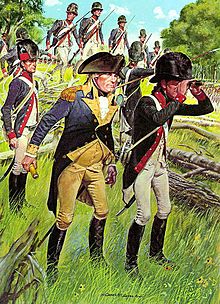| Legion of the United States | |
|---|---|
 Major General Anthony Wayne with the Legion of the United States, 1794 | |
| Active | 1792–1796 |
| Disbanded | 1796 |
| Country | |
| Branch | |
| Type | Combined arms |
| Role | Pacify Native-American tribes, secure western border for settlement |
| Size | 2,631 |
| Colors | Unit Colors:
|
| Engagements | Northwest Indian War |
| Commanders | |
| First Commander | Major General Anthony Wayne |
| Second Commander | Brigadier General James Wilkinson |
The Legion of the United States was a reorganization and extension of the United States Army from 1792 to 1796 under the command of Major General Anthony Wayne. It represented a political shift in the new United States, which had recently adopted the United States Constitution. The new Congressional and Executive branches authorized a standing army composed of professional soldiers rather than relying on state militias.[1]
The Legion was primarily formed in reaction to multiple defeats in the Ohio country in 1790 and 1791 and to assert U.S. sovereignty over U.S. borders in the western territories and Great Lakes regions. The Legion comprised four sub-legions, each with infantry, cavalry, riflemen, and artillery. The Legion is best known for its victory at the Battle of Fallen Timbers in August 1794. Following the 1795 Treaty of Greenville with the Western Confederacy of Native American nations and the Jay Treaty with Great Britain, the Legion was reduced in size and rechristened the Army of the United States in 1796.
The modern 1st, 3rd, and 4th United States Infantry Regiments of the United States Army trace their lineage to the Legion of the United States.
- ^ Kochan, James (2001). United States Army 1783–1811. Men-at-Arms Series. Osprey Military. pp. 13–15. ISBN 1-84176-087-0.